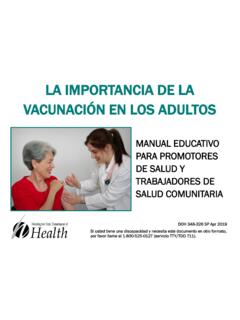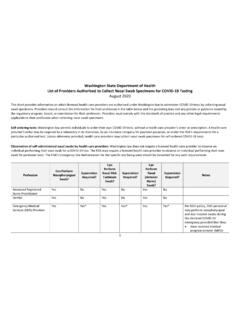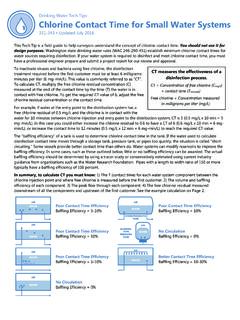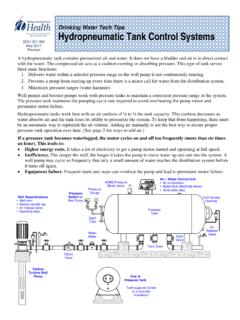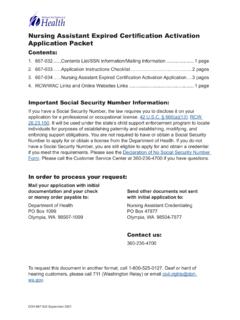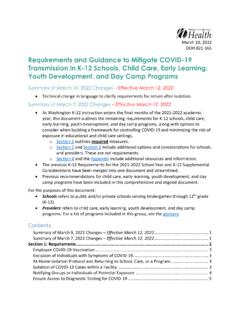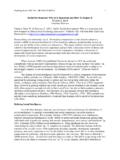Transcription of Service & Emotional Support Animals Guidance
1 March 22, 2021 DOH-821-134 Service & Emotional Support Animals Guidance Planning Guide for Local Governments M anagem ent o f Serv ice Anim als a nd Em o tio nal Sup po rt Anim als in Iso latio n L o catio ns fo r P eo ple D iagno sed with COVID-19 Contents Service & Emotional Support Animals Guidance .. 1 Purpose of this Guidance .. 2 Definition: Service animal .. 2 Patient s Rights (Handler s Rights) .. 3 Definition: Emotional Support animal .. 4 Patient Responsibilities .. 4 Service Animals and Emotional Support Animals in the COVID-19 Isolation Locations .. 4 Required Documentation .. 5 Health Concerns .. 5 Emergency Situations .. 5 Homeless Patients with Dogs Special Considerations.
2 6 Patients Accompanied by Dog without Vaccine Certification or License .. 6 2 Household Pets .. 6 Household Pet Definition .. 6 Patient Responsibilities .. 6 Funding .. 7 Resources .. 8 Authorship and Contributors .. 9 More COVID-19 Information and Resources .. 9 Purpose of this Guidance The purpose of this Guidance is to assist local governments in establishing best practices standards for people who are ill with COVID-19 and depend on a Service animal or Emotional Support animal . The guide outlines the legal definitions, patient responsibilities, safety and Support and, potential funding resources. NOTE: The Washington State Department of Health recognizes that each region of the state and each community is unique with different strengths, available resources, vulnerabilities, challenges, and needs.
3 Local jurisdictions are both empowered and responsible for their planning. Considerations in this document are not directives and are not legally binding but are informed by best practices and offered to Support local health jurisdictions and Tribal governments in their planning. This document will be periodically updated to keep current as knowledge grows and needs change. Questions and feedback from local jurisdictions, tribes, and other public health partners are welcome and valued. Please email to share thoughts or request a call to discuss further, or request technical assistance in managing Service and Emotional Support Animals in isolation locations. Definition: Service animal Per ADA a Service animal is defined by TITLE II* and TITLE III**: A Service animal means any dog that is individually trained to do work or perform tasks for the benefit of an individual with a disability, including a physical, sensory, psychiatric, intellectual, or other mental disability.
4 Tasks performed can include, among other things, pulling a wheelchair, retrieving dropped items, alerting a person to a sound, reminding a person to take medication, or pressing an elevator button. 3 Examples: Guide Dog or Seeing Eye Dog is a carefully trained dog that serves as a travel tool for persons who have severe visual impairments or are blind. A Hearing or Signal Dog is a dog that has been trained to alert a person who has a significant hearing loss or is deaf when a sound occurs, such as a knock on the door. Psychiatric Service Dog is a dog that has been trained to perform tasks that assist individuals with disabilities to detect the onset of psychiatric episodes and lessen their effects.
5 Tasks performed by psychiatric Service Animals may include reminding the handler to take medicine, providing safety checks or room searches, or turning on lights for persons with Post Traumatic Stress Disorder (PTSD), interrupting self-mutilation by persons with dissociative identity disorders, and keeping disoriented individuals from danger. SSigDOG (Sensory Signal Dogs or Social Signal Dog) is a dog trained to assist a person with autism. The dog alerts the handler to distracting repetitive movement ( hand flapping.) Seizure Response Dog is a dog trained to assist a person with a seizure disorder. How the dog serves the person depends on the person s needs. The dog may go for help.
6 A few dogs have learned to predict a seizure and alert the person to sit down or move to a safe place. * Title II Definition: Title II of the ADA prevents local public organizations from discriminating against people with disabilities. This means organizations like the local school system, hospitals, clinics, public transportation system, public housing, and other city and state government buildings. ** Title III Definition: Title III of the ADA focuses on private businesses, such as hotels, restaurants, theatres, grocery stores, and hardware stores. Patient s Rights (Handler s Rights) Titles II and III of the Americans with Disabilities Act (ADA) makes it clear that Service Animals are allowed in public facilities and accommodations.
7 A Service animal must be allowed to accompany the handler to any place in the building or facility where members of the public, program participants, customers, or patients are allowed. Even if the facility or public program has a no pets policy, it may not deny entry to a person with a Service animal . Service Animals are not pets. So, although a no pets policy is perfectly legal, it does not allow a facility or business to exclude Service Animals . 4 When a person with a Service animal enters a public facility or place of public accommodation, the person cannot be asked about the nature or extent of his disability. Only two questions may be asked: 1. Is the animal required because of a disability?
8 2. What work or task has the animal been trained to perform? These questions should not be asked, however, if the animal s Service tasks are obvious. For example, the questions may not be asked if the dog is observed guiding an individual who is blind or has low vision, pulling a person s wheelchair, or aiding with stability or balance to an individual with an observable mobility disability. A public facility is not allowed to ask for documentation or proof that the animal has been certified, trained, or licensed as a Service animal . Local laws that prohibit specific breeds of dogs do not apply to Service Animals . Definition: Emotional Support animal An Emotional Support animal is a type of animal that provides comfort to help relieve a symptom or effect of a person's disability.
9 Under law, an Emotional Support animal is not a pet and is generally not restricted by species. Certain COVID-19 I&Q facilities may be unable to accommodate certain species. NOTE: Emotional Support Animals are NOT considered Service Animals by the ADA or Washington State Law and are not protected by the laws outlined for Service Animals . Admission of ESA s is left to the discretion of the I&Q facility manager. Patient Responsibilities Service Animals and Emotional Support Animals in the COVID-19 Isolation Locations The patient is responsible for the supervision of the Service animal or Emotional Support animal and may be asked to remove the animal if: The animal is out of control and the animal s owner does not take effective action to control it ( a dog barking unabated and the owner does not correct or, is unable to correct the behavior).
10 The animal poses a direct threat to the health and safety of other Animals and/or patients and staff. The operator of the Isolation Location does not have to allow the Service animal or Emotional Support animal onto the premises if the patient is unwilling/unable to control the animal . The care and supervision of a Service or Emotional Support animal is solely the responsibility of the patient which includes feeding, toileting, grooming, and veterinary care. 5 The patient must keep the animal under physical control, on a leash, no greater than 8 (eight) feet in length, or otherwise physically restrained, at all times during the stay at the I&Q facility, especially during the daily patient evaluation The patient must ensure that the animal is restrained to allow a health care professional to approach and perform a daily assessment without interference.
